Physical Address
304 North Cardinal St.
Dorchester Center, MA 02124
Hairy cell leukemia (HCL) is one of the diseases exemplifying the importance of the application of appropriate diagnostic techniques and the importance of treatment strategies to obtain the best treatment outcomes for the individual patient. The disease was first described by Bouroncle and colleagues in 1958. The term hairy cell leukemia was first used to describe the disorder by Schreck and Donnelly in 1966 and was derived from the observation of hair-like projections from mononuclear cells, giving rise to a frayed cell surface appearance.
The evolution of therapeutic strategies in patients with HCL over the past 25 years has led to a significant change in the natural history of the disease. Using the currently available drugs, the majority of patients with this disease achieve complete response (CR), and the published survival curves from several large series are similar to those for appropriate age-matched individuals without the disease. At the same time, recent research efforts have led to a better understanding of the molecular mechanisms responsible for the disease pathogenesis. Several studies, using modern techniques, have demonstrated the persistence of minimal residual disease (MRD) after therapy with nucleoside analogs in the majority of patients, without consensus on the significance of such MRD. The role of monoclonal antibodies, naked or conjugated with toxins, in the management of HCL, as well as their ability to eradicate MRD, is under investigation. The possibility of such chemoimmunotherapy strategies, leading to further improvements in the outcome of patients with HCL, needs to be further investigated. More recently, the identification of the BRAF V600E mutation present almost universally has led to studies evaluating the role of BRAF-kinase inhibitors in this disease.
HCL is an uncommon lymphoid malignancy, accounting for only 2% of lymphoid leukemias, with approximately 600 to 800 new patients diagnosed each year in the United States. The disease is more common in white people and occurs more frequently in men than women by a ratio of 4:1. The median age at diagnosis is reported by most studies to be 50 to 59 years. However, it is possible that the disease is underreported in the older population. The Swedish Cancer Registry has maintained records on the incidence of the disease for several decades and has shown a stable incidence since the 1980s. It reports the median age at diagnosis to be 62 years, suggesting less rigid diagnostic efforts in older patients.
HCL has been diagnosed in patients aged in their 20s and 30s but is exceptionally rare in children. Using data from the 17 population-based cancer registry areas in the United States, the National Cancer Institute’s Surveillance Epidemiology and End Results program reported that the incidence of the disease was stable in the decades between 1978 and 2004, with a rapid rise in age-specific incidence ratios until approximately age 40 years and then at a slower pace beyond that age.
Several reports have suggested an association between development of HCL and exposure to benzene, organophosphorus insecticides, and other solvents. However, such association has not been confirmed by other reports. Exposure to radiation, wood dust, or agricultural chemicals, and a previous history of infectious mononucleosis have also been suggested as predisposing factors. However, a direct, causal association has not been established with any of these or other factors.
Morphologically and phenotypically, the cells in HCL have no resemblance to any of the normal stages of B-cell development and maturation; past studies have debated the cell of origin. Initially, because of morphologic and functional similarities between hairy cells and cells of the monocyte/macrophage system, HCL-tumor cells were thought to be derived from a cell transformed from the reticuloendothelium. Prior studies have demonstrated the rearrangement of the B-cell receptor (BCR) immunoglobulin genes in HCL, demonstrating the B-cell origin of the disease. Several studies have increased our understanding of the cell of origin in HCL, allowing for a better description of pathogenic mechanisms responsible for its development.
In lymphoid cells, the analysis of the immunoglobulin variable region genes provides a tool for the delineation of the clonal history of cells at which lymphoid neoplasms originate, identifying whether antigen encountered by a normal mature B cell has resulted in somatic mutation ( Fig. 77.1 ). This process occurs within the germinal centers (GCs) of lymph tissues and may be associated with isotype switching. The enzyme activation−induced cytidine deaminase (AICD) is critical for both processes. Tumor cells from various B-cell malignancies are arrested at a number of stages along normal B-cell differentiation, conserving the immunogenetic characteristics of the stage-specific cell. The analysis of immunoglobulin variable gene regions can provide information about whether the cell of origin has undergone somatic mutation and isotype switching. Several reports have clearly demonstrated that in more than 85% of patients with HCL, the tumor cells express switched immunoglobulin isotypes, and their rearranged variable region genes have undergone somatic mutations. Furthermore, HCL cells express AICD, the enzyme that is critical for both processes. This suggests that the cell of origin in the majority of HCL cases has transited through the GCs of peripheral lymphoid tissue, having undergone the GC reaction. Of interest, in about 40% of cases of HCL, the leukemia cells express multiple immunoglobulin heavy (IGH)-chain isotypes with dominance of immunoglobulin G3 (IgG3) but only a single light chain, suggesting that clonally related, multiple isotypes coexist in single hairy cells. Therefore, this subset of the disease may be arrested at a point after isotype switching and before exit from the GC. However, other lines of evidence suggest a post-GC origin.
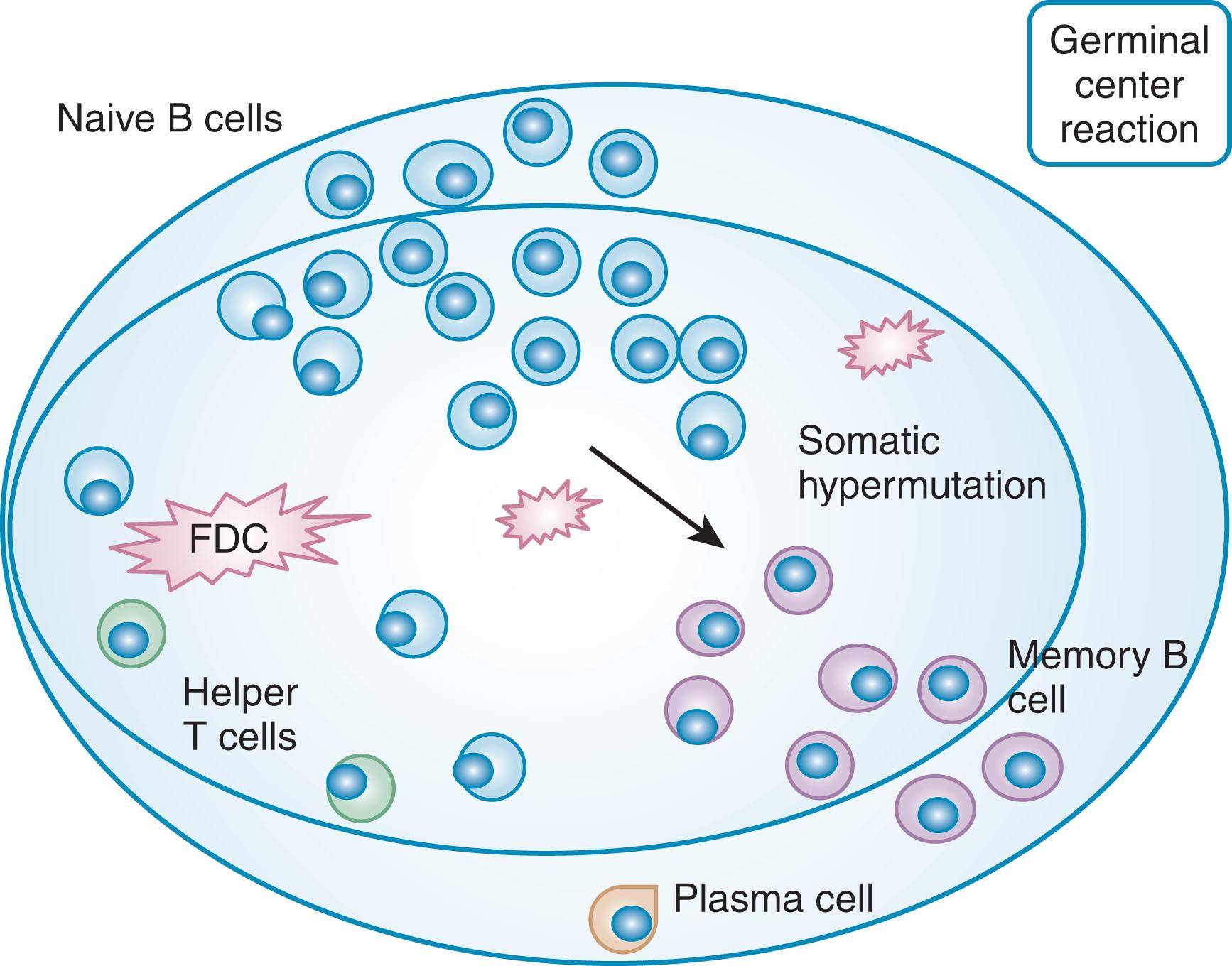
Arons and colleagues have provided evidence that in the majority of patients with classic HCL (83% of 102 cases), the cell of origin is post-GC with a mutated IGH-chain variable region. This is contrasted with historic data for patients with chronic lymphocytic leukemia, in which case, about half of the time the cell of origin is un-mutated. They also reported higher usage of certain immunoglobulin-gene families and a difference in mutational frequency among these genes. Furthermore, by demonstrating that the mutations fulfilled predefined characteristics of a canonic and non-random event, Arons and colleagues provided further evidence suggestive of an antigen-driven process.
The post-GC origin of HCL is supported by gene-expression profiling studies, comparing HCL cells with cells from other lymphoid neoplasms and with naïve and memory B cells. HCL patients displayed a homogeneous pattern of gene expression that was clearly distinct from other B-cell lymphomas and was related to post-GC memory B cells. Other investigators have reported this remarkably stable genome in HCL. Furthermore, when compared with memory B cells, HCL cells had a remarkable conservation of proliferation, apoptosis, and DNA metabolism programs but differed significantly in the expression of genes controlling cell adhesion and response to chemokines. Against the hypothesis of a memory B-cell origin is the lack of expression by hairy cells of the memory B-cell marker, CD27. However, CD27-negative memory B cells have been described in humans, and hairy cells may lose this marker as a result of the neoplastic transformation.
As lymph node involvement in HCL is uncommon, the post-GC cell of origin is likely to originate from the spleen or the bone marrow, which are sites involved by the disease almost invariably. A number of reports have suggested that HCL may originate from the B cells of the splenic marginal zone (SMZ). Normal SMZ B cells are mainly memory B cells. Vanhentenrijk and colleagues, using comparative expressed sequence hybridization studies, demonstrated that hairy cells had an expression profile consistent with a splenic-expression signature that most likely reflected the expression profile of spleen-specific components, such as the sinusoidal-lining cells from the red pulp and the marginal-zone B cells from the white pulp.
Tiacci and colleagues reported the presence of BRAF V600E mutations in each of 47 patients with HCL and no mutations in the cells from patients with 195 peripheral B-cell lymphomas or leukemias. Using whole-genome sequencing, in an index patient they identified five missense somatic clonal mutations, including a heterozygous mutation in BRAF that resulted in a BRAF V600E variant protein. Since BRAF V600F is known to be oncogenic in other tumors, Tiacci and colleagues focused on this mutation and analyzed the subsequent 46 cases, as well as the patients with other lymphomas. They also demonstrated expression of phosphorylated MEK and extracellular signal-related kinase (ERK), showing constitutive activation of the RAF-MEK-ERK mitogen-activated, protein kinase pathway in HCL. The presence of the BRAF V600E mutation in the hematopoietic stem cells (HSC) in patients with HCL, and the stable engraftment of BRAF V600E mutant HSC from a HCL patient into immunodeficient mice that results in a HCL-like disease are further indications of the central role of this mutation to the pathogenesis of HCL. Other studies have further characterized the mutational landscape in HCL, with CDKN1B mutations found in one study to be the second most common mutated gene in HCL.
Typically, the majority of patients present with pancytopenia and splenomegaly with the associated fatigue, upper-left quadrant abdominal pain, fever, infections, and/or bleeding problems ( Table 77.1 ). Common presenting features include significant anemia seen in up to 85% of patients, thrombocytopenia seen in about 60% to 80%, and leukopenia seen in 60% of patients; these cytopenias can be severe and life-threatening and are likely multifactorial, with hypersplenism and marrow infiltration being the more important contributors. Monocytopenia is a characteristic finding. Circulating hairy cells are typically scant in most patients or frequently absent. Hairy cells are small- and medium-sized lymphoid cells with an oval or indented (bean-shaped) nucleus and with less clumped homogeneous chromatin than in normal B cells ( Fig. 77.2 ). Nucleoli are typically absent or inconspicuous, and the cytoplasm is typically abundant and pale blue in color with circumferential “hairy,” projections. Electron micrographs of hairy cells clearly demonstrate their distinctive and complex surface features with multiple surface folds and clusters of short microvilli, creating an appearance unique to hairy cells ( Fig. 77.3 ).
|
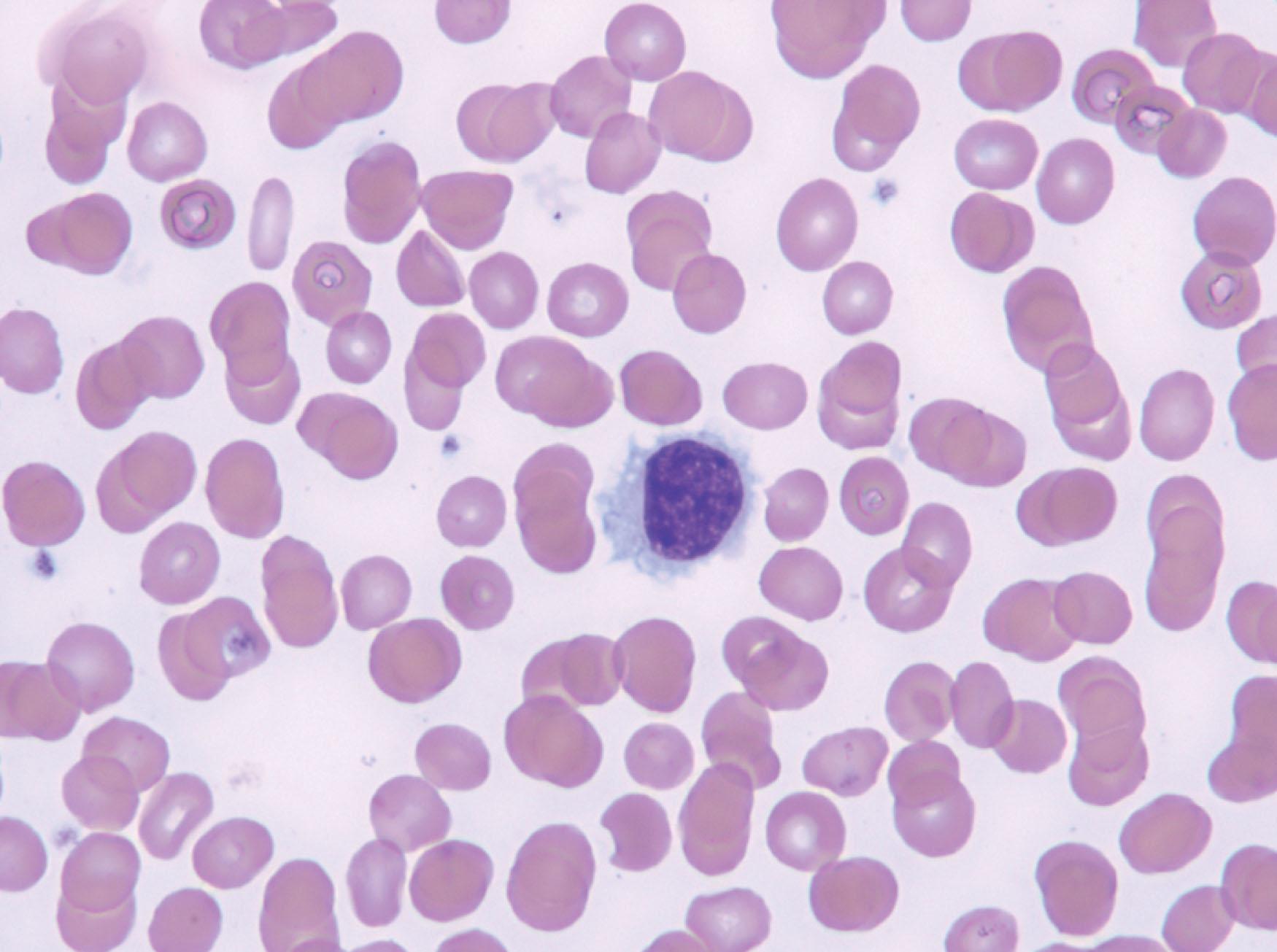
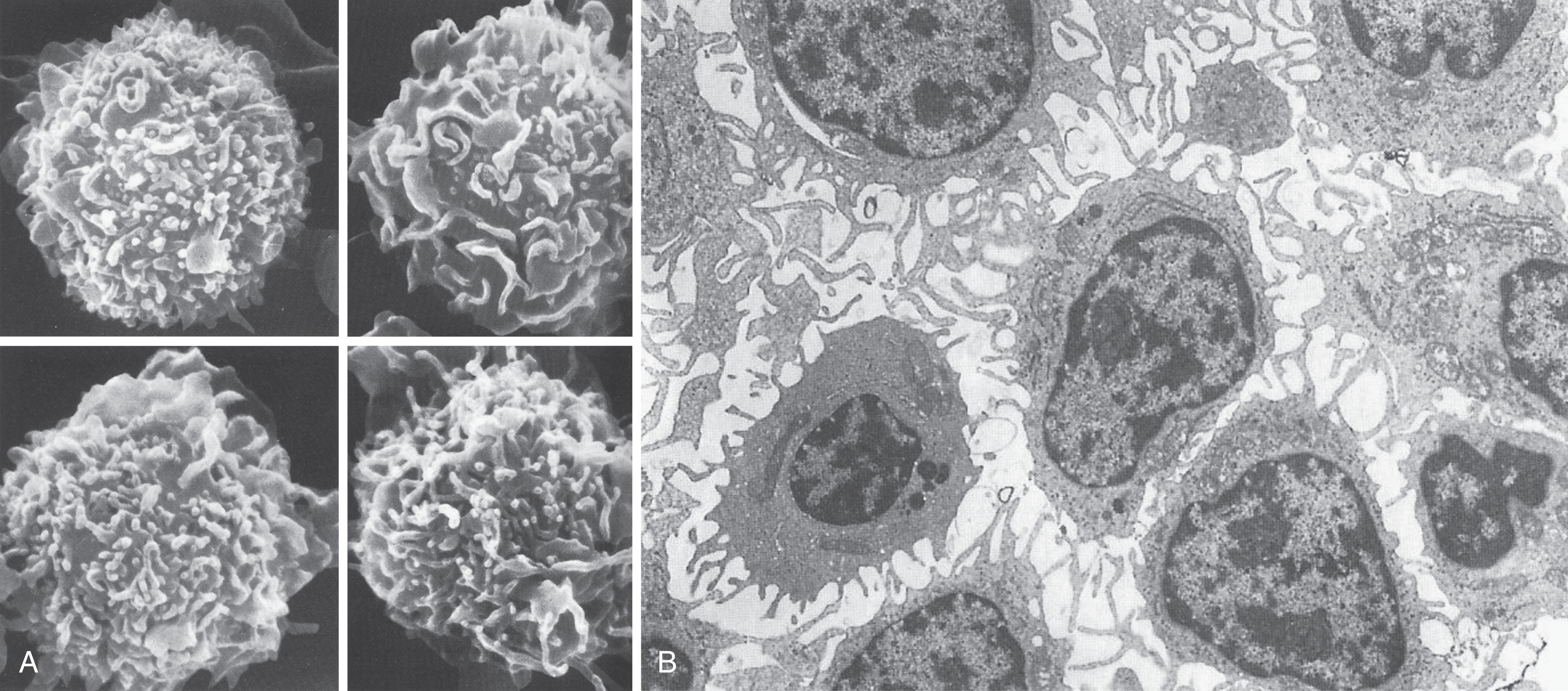
Bone marrow involvement can be interstitial or patchy. The infiltrate is characterized by widely spaced nuclei because of the abundant cytoplasm, giving rise to the commonly described “fried egg,” appearance ( Fig. 77.4 ). Occasionally, an increase in the bone marrow reticulin fibrosis, as well as significant loss of the hematopoietic elements, leads to a “dry tap.” Bone marrow fibrosis is caused by the production and assembly of a fibronectin matrix by hairy cells and the deposition of fine reticulin fibers (mainly composed of type III collagen fibrils) by fibroblasts. Hairy cells express isoenzyme 5 of acid phosphatase, which imparts resistance to treatment with tartaric acid, resulting in virtually all cases being positive for tartrate-resistant acid phosphatase (TRAP) ( Fig. 77.5 ). Combined expression of DBA44 and TRAP by immunohistochemical analysis is highly specific and useful for arriving at the diagnosis. More recently, immunostaining for annexin A1 (ANAX1) has been reported to be very specific for HCL. ANAX1 can be used to distinguish HCL from its variant form and from other lymphoid neoplasms, such as splenic marginal zone lymphoma (SMZL). Cyclin D1 (encoded by CCND1 gene) is frequently expressed, but this is not secondary to translocation involving CCND1 , unlike mantle cell lymphoma. In a proportion of patients, the bone marrow is hypocellular with the loss of hematopoietic elements, which can result in an erroneous diagnosis of aplastic anemia. Immunostaining for antigens, such as CD20, may be helpful to detect the abnormal B-cell infiltrate, hence prompting more specific stains for HCL.
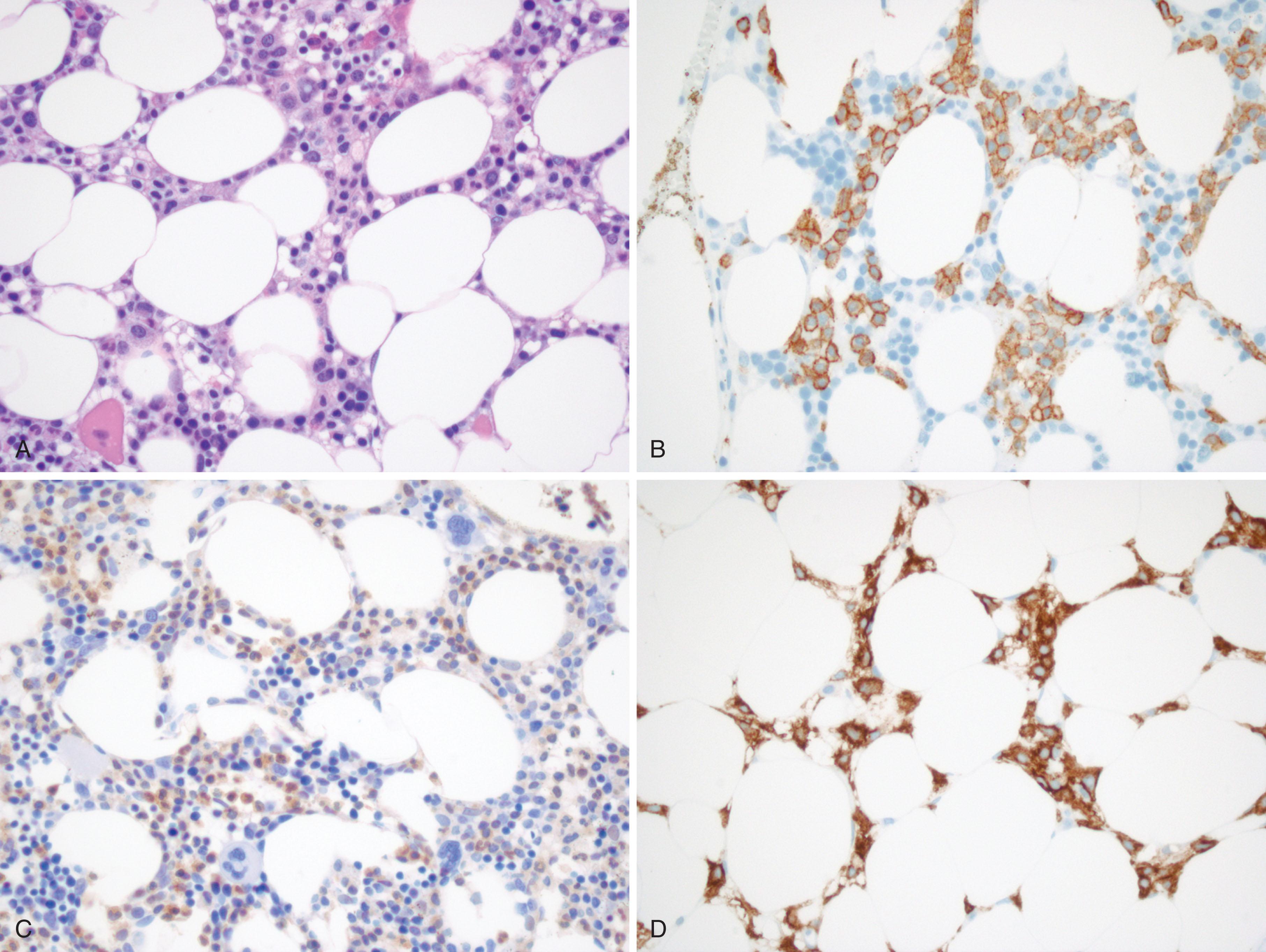
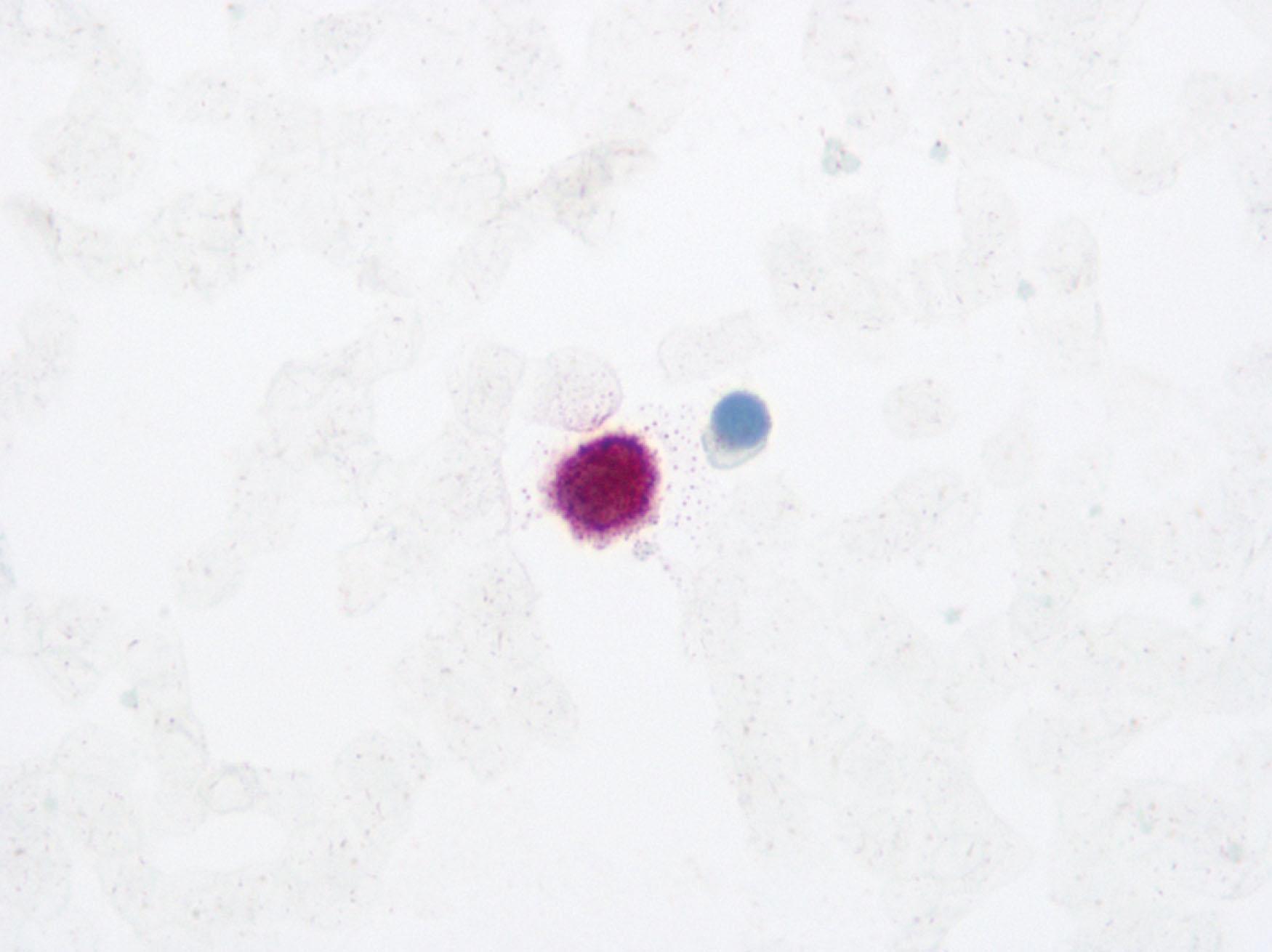
HCL cells have a characteristic immunophenotype, with flow cytometry being an important element of diagnostic evaluation in this disease (see Table 77.1 ). Hairy cells strongly express CD45 and gate within the monocytic region when analyzed by CD45 versus side scatter, which is typically devoid of monocytes. They exhibit a mature B-cell phenotype and commonly express one or more heavy chains and monotypic light chains (κ and λ light chains in equal numbers of patients). They express B-cell-associated antigens CD19, CD20, CD22, FMC7, and CD79b but typically lack CD5, CD10 (positive in about 10%), and CD23 (positive in about 20%) expression. No single marker is specific for distinguishing HCL from other B-cell neoplasms; however, the antigens CD11c, CD103, CD123, as well as the interleukin (IL)-2 receptor α-subunit (CD25), are typically expressed in HCL. Bright expression of CD22 and CD20 is also seen, which can be important therapeutically. Among the patients evaluated in one study, CD52 was also universally expressed.
Splenic enlargement is present in the majority of patients and can be massive in about 20% of cases. Splenic involvement is characterized by diffuse infiltration of the red pulp cords and sinuses, with atrophy and replacement of white pulp. Blood-filled sinuses lined by hairy cells (often referred to as pseudosinuses or red blood lakes ) are often a prominent but not a pathognomonic finding ( Fig. 77.6 ). Significant lymphadenopathy is uncommon and present only in the advanced stages of the disease. When involved, the lymph node enlargement is largely confined to the abdominal and retroperitoneal nodes. The infiltrates are distributed in the interfollicular and paracortical areas of the nodes and may extend through the capsule to the surrounding adipose tissue. Hepatomegaly is much less frequent, occurring in up to a third of patients. However, the liver is almost always involved with a mononuclear cell infiltrate in the sinusoids, portal areas, or both. Unusual sites of disease involvement have been reported, including mediastinal and paravertebral masses, skeletal lytic lesions, pleural effusions, and ascites, as well as involvement of the skin, the eye, the central nervous system, and the gastrointestinal tract. Other notable clinical features include a predisposition to infections and an uncommon association with autoimmune disorders, such as polyarteritis nodosa, vasculitis, and rheumatoid arthritis.
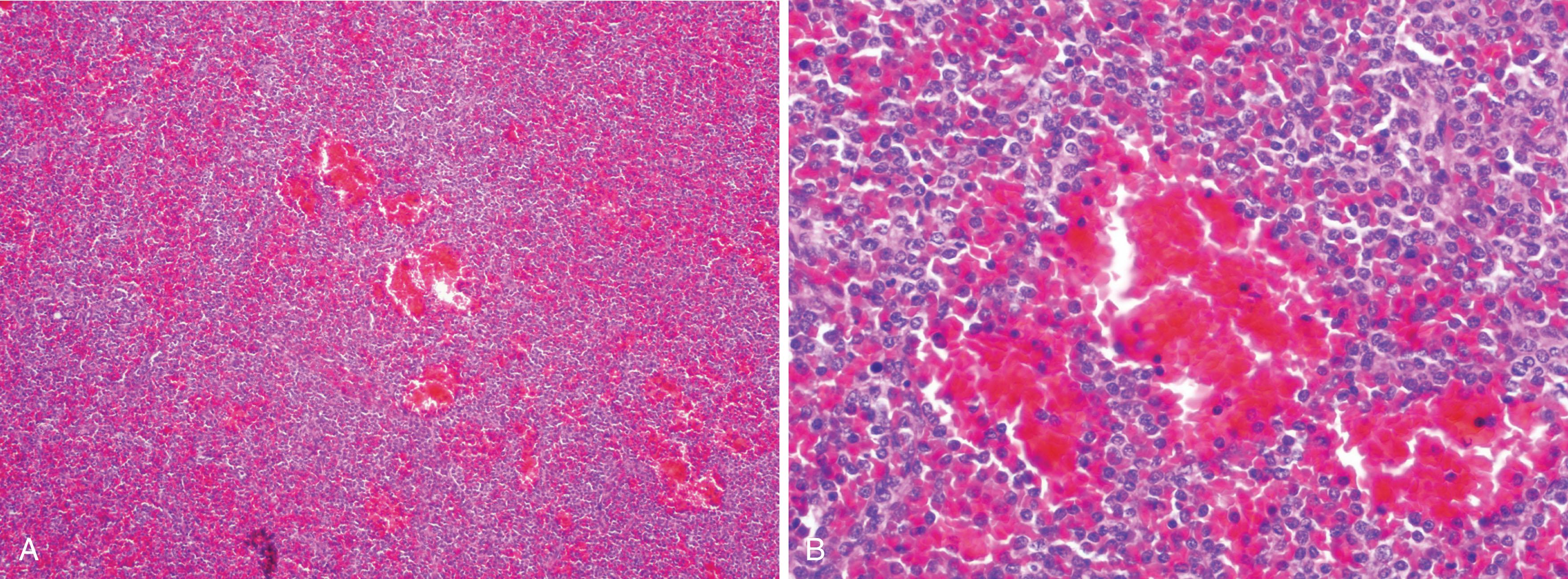
Several cytogenetic abnormalities have been reported in HCL, but no single abnormality is present consistently. Few cytogenetic studies have been reported because of the rarity of the disease, difficulty in obtaining marrow samples, and low responsiveness of hairy cells to common mitogens. In the reported series, chromosomes 1, 2, 5, 6, 11, 14, 19, and 20 are most frequently involved, with chromosome 5 and 14 abnormalities predominating. Deletions and mutations of p53, as well as overexpression of cyclin D1, have been reported. Lack of reciprocal, chromosomal translocations in HCL is consistent with a memory B-cell origin of the disease because these translocations are thought to arise from mistakes in the immunoglobulin remodeling mechanisms, which are believed to be turned off in memory B cells.
HCL must be distinguished from other indolent lymphoid neoplasms, such as B-prolymphocytic leukemia and SMZL, and most notably, from HCLv, the variant form of the disease. HCLv is a rare disorder accounting for approximately 10% of cases and occurring in an older population, with the median age being 71 years. No reports exist of an association with exposure to carcinogens, radiation, or viral infections, and no specific underlying cause has been described. Patients often have an elevated WBC count (>10 × 10 9 /L), including atypical hairy cells with prolymphocytic features and lack monocytopenia. Splenomegaly and cytopenias are present in the majority of patients. The patterns of bone marrow and splenic involvement is similar to HCL and is different from prolymphocytic leukemia and SMZL. The immunophenotypic expression of various lymphoid markers is also different in these disorders, with HCLv lacking CD25 expression, further assisting diagnosis (Table 78.2). Another aid in distinguishing HCL from HCLv is CD123 expression, which is positive in the former and negative in the latter. A number of chromosomal abnormalities, including translocations, have been reported in a few cases. Although HCLv has some similarities to HCL, the two conditions differ in a number of features, most notably being HCLv’s lack of responsiveness to classic HCL therapies. As such, it is important to distinguish the two and consider them as separate diseases. HCL and HCLv have different IGH-chain gene repertoires and somatic hypermutation patterns. A recent report also suggested that high expression levels of AICD can distinguish HCL from HCLv and from SMZL. However, the same group was unable to find distinct cytogenetic events to distinguish HCL from its variant, using high-resolution genomic profiling. Most recently, BRAF V600F mutations have been shown to occur exclusively in HCL samples and not in those from patients with HCLv and SMZL.
SMZL (previously referred to as splenic lymphoma with villous lymphocytes [SLVL] ) exhibits some of the clinical and morphologic features of HCL but typically has a more prominent peripheral blood involvement, lacks TRAP expression, and has a different immunophenotype, including absence of expression of CD25 and CD103. HCL should be distinguished from other indolent lymphoid neoplasms, such as chronic lymphocytic leukemia, prolymphocytic leukemia, and follicular lymphomas, but this distinction is typically easily made using the characteristic, morphologic, and immunotypic findings of these disorders (see Table 77.2 ). Other disorders that should be included in the differential diagnosis include aplastic anemia, primary myelofibrosis, and systemic mast cell disorders.
| Disease | sIg | CD5 | CD10 | CD11c | CD20 | CD22 | CD23 | CD25 | CD103 |
|---|---|---|---|---|---|---|---|---|---|
| HCL | +/− | −/+ | − | ++ | + | + | −/+ | + | ++ |
| CLL | +/− | ++ | − | −/+ | +/− | −/+ | ++ | −/+ | − |
| B-PLL | ++ | + | − | −/+ | +/− | + | +/− | − | − |
| HCLv | +/− | − | − | ++ | + | + | − | − | −/+ |
| MCL | + | ++ | − | − | + | + | −/+ | − | − |
| SMZL | + | −/+ | −/+ | + | + | +/− | −/+ | − | − |
| FL | + | − | + | − | ++ | + | −/+ | − | − |
Become a Clinical Tree membership for Full access and enjoy Unlimited articles
If you are a member. Log in here